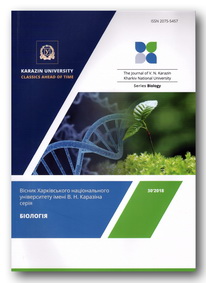Seasonal changes of free-living ciliate communities in different biotopes of the Agzibir Lake
Abstract
The Agzibir Lake is optimal in terms of hydrochemical and hydrobiological factors for formation of higher biodiversity of free-living ciliates. This is facilitated with continuous entering biogenic elements as a result of metabolism of large bird colonies and decaying organic residues of plant and animal origin. The Agzybir Lake having a link with the Caspian Sea in spring and fall is a place of spawning and the subsequent development of larvae of many commercially valuable fishes of the Caspian Sea, for which ciliates are a valuable starting food source in early stages of ontogenesis. During 2014–2019, totally 169 species of free-living ciliates were found by us, and 34 of them were observed for the first time for the Caspian fauna. The minimum species diversity was observed in plankton, where 46 species were recorded. In benthos of the sandy biotope, 58 species were found, whereas in the silty sand one, 80 species. At the silt soil in the biotope of gray silt, we found 72 species, the maximum species diversity (84 species) was observed in the silt biotope with plant residues, while at the black silt with sapropel communities 66 species of free-living ciliates were found. In the periphyton biotope, we observed 71 species, while in coastal thickets of algae (phytociliocenosis) 79 species of free-living ciliates were found. As with the sandy biotope, the black silt biotope, sometimes with small communities of sapropel silt, is much smaller in area than the rest of benthic biotopes of the Agzibir Lake. Yet, free-living ciliate communities of black silt are specific and include several species that are tolerant to low oxygen and hydrogen sulfide in water. The seasonal variations of total quantity of free-living ciliates of benthic biotopes have three maxima (in spring, summer and autumn). As for the rest of biotopes of plankton, periphyton and phytociliocenosis, only two maxima (in spring and autumn) were revealed. The greatest similarity of species diversity was observed within benthic communities. But lowest similarity was observed between sapropel silt and the rest. As was already mentioned, this is due to specific ecological conditions of sapropel silt biotope.
Downloads
References
Abdullayev A.I., Nadirov S.N., Akhundov M.M. (2014). Evaluating the role of Devechinsky estuary in the reproduction of commercial semipermeable carp fish species stocks / In: Current state of bio-resources of inland waters. Moscow: Polygraph-plus, pp. 11–16. (In Russian)
Alekperov I.Kh. (1992). The new modification of impregnation ciliates kinetome with silver proteinate. Zool. J., 2, 130–133. (in Russian)
Alekperov I.Kh. (2005). An atlas of the freeliving ciliates (Classes Kinetofragminophora, Colpodea, Oligohymenophorea, Polyhymenophora). Baku: Publishing house Borchali. 310 p. (In Russian)
Alekperov I.Kh. (2012). Free-living infusoria of Azerbaijan (ecology, zoogeography, practical importance). Baku: Elm Publishing House. 520 p. (In Russian)
Alekperov I.Kh., Mansimova I.F. (2017). The ratio of trophic groups of free-living ciliates on the seasons of the year in the Agzibir Lake. Journal of Entomology and Zoology studies, 5(1), 395–399.
Chatton E., Lwoff A. (1930). Imprégnation, par diffusion argentique, de l'infraciliature des ciliés marins et d'eau douce, après fixation cytologique et sans desiccation. Comptes Rendus des Séances de la Société de Biologie, 104, 834–836.
Dragesco J., Dragesco-Kerneis A. (1986). Ciliés libres de l'Afrique intertropicale: introduction à la connaissance et à l'étude des Ciliés. Paris: ORSTOM. 562 p. (Faune Tropicale, 26).
Foissner W., Blatterer H., Berger H., Kohmann F. (1991). Taxonomische und ökologische Revision der Ciliaten des Saprobiensystems. Band I: Cyrtophorida, Oligotrichida, Hypotrichia, Colpodea. Informationsberichte des Bayerischen Landesamtes für Wasserwirtschaft, 1/91. 478 p.
Kasimov A.G. (1972). Freshwater fauna of the Caucasus. Baku: "Elm". 286 p. (In Russian)
Sørensen T. (1948). A method of establishing groups of equal magnitude in plant sociology. Kongelige Danske Videnskabernes Selskab. Biologiske Skrifter, 5(4), 1–34.
Witzani G., Nowacki M. (eds.). (2016). Biocommunication of Ciliates. Springer. 372 p. https://doi.org/10.1007/978-3-319-32211-7
Authors retain copyright of their work and grant the journal the right of its first publication under the terms of the Creative Commons Attribution License 4.0 International (CC BY 4.0), that allows others to share the work with an acknowledgement of the work's authorship.




